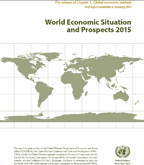Global economic growth is predicted to increase by just over three percent over the next two years, according to the UN's latest World Economic Situation and Prospects (WESP) report.
In 2014, the report explains, global expansion preceded at a moderate, uneven pace, due in part to legacies from the global financial crisis, geopolitical conflicts and the Ebola epidemic.
The report recommends strengthening international policy coordination and aligning global macroeconomic policies to reduce risks, create productive jobs and maintain long-term economic and financial stability.
 10 December 2014: Global economic growth is predicted to increase by just over three percent over the next two years, according to the UN’s latest World Economic Situation and Prospects (WESP) report. In 2014, the report explains, global expansion preceded at a moderate, uneven pace, due in part to legacies from the global financial crisis, geopolitical conflicts and the Ebola epidemic. The report recommends strengthening international policy coordination and aligning global macroeconomic policies to reduce risks, create productive jobs and maintain long-term economic and financial stability.
10 December 2014: Global economic growth is predicted to increase by just over three percent over the next two years, according to the UN’s latest World Economic Situation and Prospects (WESP) report. In 2014, the report explains, global expansion preceded at a moderate, uneven pace, due in part to legacies from the global financial crisis, geopolitical conflicts and the Ebola epidemic. The report recommends strengthening international policy coordination and aligning global macroeconomic policies to reduce risks, create productive jobs and maintain long-term economic and financial stability.
The UN Department of Economic and Social Affairs (DESA), the UN Conference on Trade and Development (UNCTAD), the five UN regional commissions and the World Tourism Organisation (UNWTO) launched the WESP in New York, US, on 10 December 2014. The annual report serves as a reference point for discussions on economic, social and related issues taking place throughout the UN. The full version of the report will be released 19 January 2015.
“Some economic indicators are positive and moving in the right direction,” observed Pingfan Hong, DESA. He cautioned that, while such trends suggest potential for a gradual return to consistent economic growth, “many risks and uncertainties could dash efforts to get the global economy on track and moving forward.”
The WESP also observes: historically high unemployment figures in some regions; “subdued” global inflation alongside high inflation in some developing countries and deflation risks in the Eurozone; and an expected increase in trade growth. It identifies foreign direct investment (FDI) flows as the most relevant and stable source of financing for developing countries.
In 2014, the US maintained an annual growth rate above two percent while a number of EU members “teetered on the brink of recession.” In 2015-2016, the US economy is predicted to improve, Western Europe is expected to experience “only a slight improvement in growth,” and Japan’s growth is projected to slow as a result of a higher consumption tax.
Among the economies in transition, large emerging economies in Latin America and the Commonwealth of Independent States (CIS) experienced a sharp deceleration, according to the WESP. South Asia, led by India, experienced a moderate increase, while East Asia, including China, experienced a mild slowdown. The Russian Federation is projected to experience near-zero growth.
East Asia is expected to remain the fastest growth region among developing countries, with a growth rate of above six percent in 2015 and 2016. Africa’s growth is projected to accelerate in 2015 and 2016. South Asia is expected to gradually increase, while Latin America and the Caribbean are predicted to moderately improve.
Looking ahead, the WESP states recovery in the Eurozone remains precarious and great risks remain. It explains that growth momentum has slowed to a point at which “an exogenous event could lead to a return to recession.” The WESP also observes that many developing countries and economies in transition appear vulnerable to tightening financial conditions and expresses concern about high current-account deficits in Brazil, Indonesia, South Africa and Turkey. [DESA Press Release] [Report Website] [Pre-Release WESP 2015]